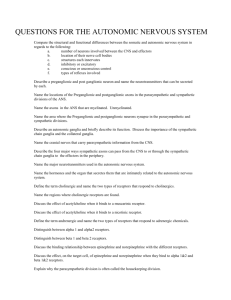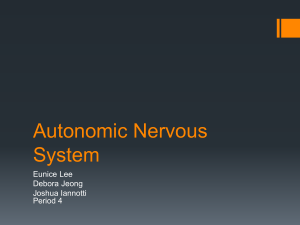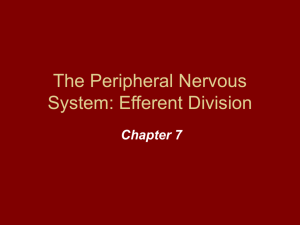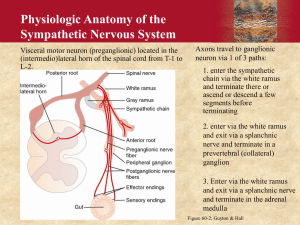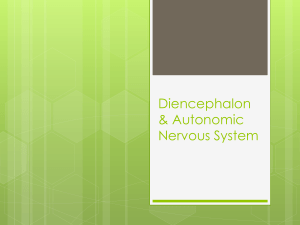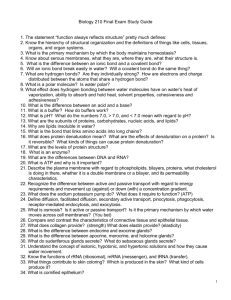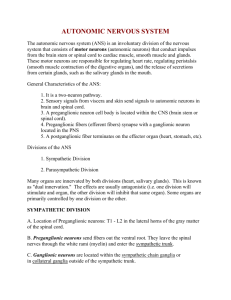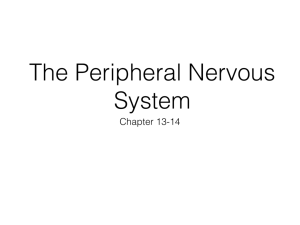Bio 241 Unit 4 Lecture 7 PP
advertisement
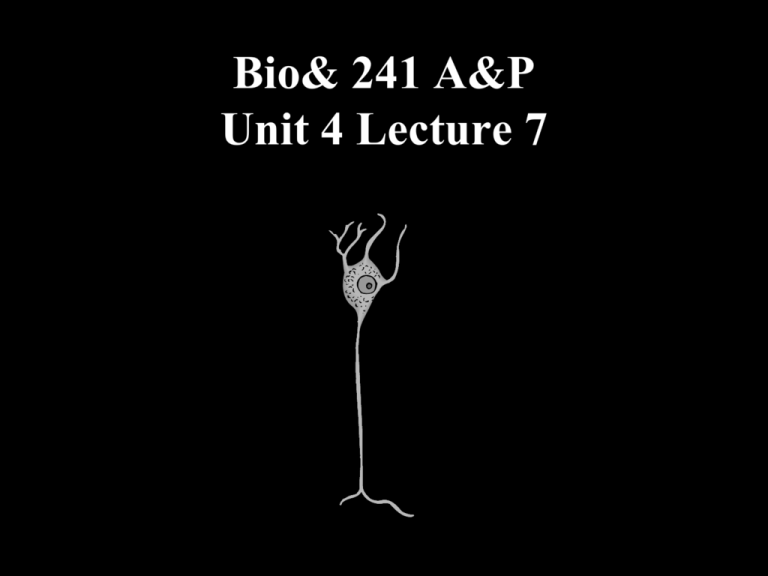
Bio& 241 A&P Unit 4 Lecture 7 Basic Patterns of the Autonomic Nervous System • Preganglionic fibers arise in the CNS and are myelinated “B” fibers. • Postganglionic fibers arise in autonomic ganglia outside the CNS and are unmyelinated “C” fibers. • These Postganglionic fibers produce either IPSP’s or EPSP’s at the organs they innervate. • Consists of two antagonistic systems: Sympathetic and Parasympathetic • The role of the ANS is to maintain homeostasis • Controlled by hypothalamic centers Comparison of the Somatic and Autonomic Nervous Systems Role of the Sympathetic system in maintaining homeostasis • The Sympathetic system responds to “E” situations (exercise, emergency, excitement, and embarrassment) collectively called a “fight-or-flight response. • During sympathetic stimulation, this system dominates or overrides the parasympathetic branch Role of the Parasympathetic system in maintaining homeostasis • Parasympathetic system responses support body functions that conserve and restore body energy during times of rest and recovery. Its responses can be remembered by “SLUDD” (salivation, lacrimation, urination, digestion, and defecation) • Intense fear referred to as “paradoxical fear,” the massive over-stimulation of parasympathetic system, which results in loss of control over urination or defecation. Basic patterns of the Sympathetic division of the ANS • Short Preganglionic fibers arise in the CNS and are myelinated “B” fibers. • Preganglionic fibers arise as part of spinal nerves T1 – T12 and L1 and L2 (thoracolumber) • Long Postganglionic fibers arise in autonomic ganglia, either paravertebral or prevertebral ganglia, outside the CNS and are unmyelinated “C” fibers Basic patterns of the Parasympathetic division of the ANS • Long Preganglionic fibers arise in the CNS and are myelinated “B” fibers. • Preganglionic fibers arise as part of cranial nerves III, VII, IX, and X and S2, S3, And S4 (Craniosacral). • Short Postganglionic fibers arise in autonomic ganglia, associated with visceral organ except for cranial nerves III, VII, and IX, outside the CNS and are unmyelinated “C” fibers Comparison of the Sympathetic and Parasympathetic divisions of the ANS Neurotransmitters and Receptors of the Parasympathetic division • Preganglionic fibers release Ach from their synaptic end bulbs. • Postganglionic dendrites contain ligand-gated channels referred to as “nicotinic” receptors due to the effects of nicotine on these receptors. • Postganglionic fibers also release Ach from their synaptic end bulbs. • Effector membranes contain ligand-gated channels referred to as “muscarinic”receptors due to the effects of muscarine, the poison found in mushrooms, on these receptors. Neurotransmitters and Receptors of the Sympathetic division • Preganglionic fibers release Ach from their synaptic end bulbs. • Postganglionic dendrites contain ligand-gated channels referred to as “nicotinic” receptors due to the effects of nicotine on these receptors. • Postganglionic fibers release “NE” Norepinephrine from their synaptic end bulbs. • Effector membranes contain ligand-gated receptors referred to as “adrenergic” receptors that occur in two forms (alpha 1 and alpha 2 receptors) which allows for IPSP and EPSP Summary of Neurotransmitters and receptors of the ANS Enhancement of the Sympathetic branch by the Adrenal Medulla • The Adrenal Medulla is one exception to the basic pattern of the Sympathetic branch. • Pregangloinic fibers innervate the adrenal medulla via the Celiac ganglion. No postganglionic fiber are present. • Chromaffin cells of the medulla release compounds that act as neurotransmitters but circulate in the blood like hormones. • These cells of the medulla release a mixture composed of 80% epinephrine, 20% norepinephrine and a trace of dopamine. Enhancement of the Sympathetic branch by the Adrenal Medulla • Effector membranes contain a second or different group of ligand-gated “adrenergic” receptors referred to as Beta receptors. Beta receptors occur in three forms ( beta 1, beta 2, beta 3) which allow for both EPSP and IPSP • Epinephrine released by Chromaffin Cells targets beta receptors thus enhancing the overall sympathetic effect • Norepinephrine released by Chromaffin Cells targets alpha receptors also enhancing the overall sympathetic effect. Activities of the Sympathetic System Effector Radial iris muscle Circular iris muscle Ciliary Muscle Cardiac Muscle Sympathetic (+) contraction causes dilation No known effect (-) relaxation for far vision (+) Increased HR and force of contraction Parasympathetic No known effect (+) contraction causes constriction (+) contraction for near vision (-) Decreased HR and force of contraction Activities of the Sympathetic System Effector GI Smooth muscle GI sphincters Gallbladder Pancreas Sympathetic (-) decreased contraction (+) increased contraction (-) relaxation Parasympathetic (+) increased contraction (-) decreased contraction (+)contraction and release of bile (-) Inhibits release (+) promotes release of enzymes, of enzymes, promotes secretion promotes secretion of glucagon of insulin Activities of the Sympathetic System Effector Adipose tissue Liver Lungs Urinary bladder Sympathetic (+) Promotes lipolysis and release of triglycerides to blood (+) glycogenolysis gluconeogenesis (-) relaxation and airway dilation (-) relaxation of wall, (+) increases sphincter Parasympathetic No known effect (+) glycogenesis (+) contraction and airway constriction (+) contraction of wall, (-) relaxation of sphincter Activities of the Sympathetic System Effector Sweat glands Arrector pili muscle Penis/ Clitoris Prostate Seminal vesicles Sympathetic Parasympathetic (+) increases No known effect sweating (+) contraction No known effect erection of hairs (-) vasocontriction (+) vasodilation and erection (+) contractions and ejaculation No known effect Activities of the Sympathetic System Effector Vagina Uterus Sympathetic Parasympathetic (+) contractions No known effect and female orgasm (+) contractions in Minimal or pregnant uterus unknown effect
